How to install capacity for sewage
In order for your stay in the house to be comfortable and cozy, the sewage drainage equipment is a must. The most convenient way to connect to the central sewage system of the city, then you will avoid various problems and worries. But it is not always possible to implement. Therefore, the owners of private houses or cottages are forced to equip special cesspools on their sites. This may solve the problem, however, there are some nuances. If you make it technologically correct, such a pit will cost you dearly, and the labor costs will be large. Moreover, to ensure perfect tightness in cement-brick structures is almost impossible. In Russia, in the middle lane, the groundwater is quite high, so all the contents will be constantly on the surface of the site, polluting it and spreading unpleasant odors. That is why the usual cesspools have been replaced by special tanks that are designed to collect and store waste. These tanks are large tanks and tanks in which the waste is sealed until the tank is clean. From this article you can learn how to install capacity for sewage on your site yourself.
Varieties of waste storage tanks
If we talk about the types of such tanks, then there are two:
- Septic.
- Accumulative capacity.
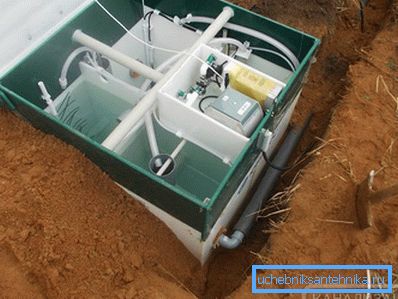
A septic tank is not just a reservoir in which sewage is collected and stored, it is partially filtered. When sewage enters the septic tank, it enters through the pipe into the first treatment chamber, where it disintegrates into various separate fractions. Large solid particles are deposited on the bottom, and small elements with water are transferred to another chamber, where they are “attacked” by bacteria. Digestion processes take place in these chambers, as a result of which methane is released. In the third compartment, this water is partially filtered and falls into the ground. That is why in some localities put septic tanks is prohibited.
The storage tanks are simply completely sealed and resemble a large tank or barrel for storing something, and the leakage of waste from the sewer into the ground in this case is excluded. It turns out that such containers can be used in any terrain. The distinctive features of such tanks include their shape and size. They are made both vertical and horizontal forms, and also have a rectangular or cylindrical design. If we talk about their spaciousness, the finished products can contain a sufficiently large volume - from 1 to 150 m3 fluid. These designs are equipped with two holes:
- the first hole is the entrance to which the sewer pipeline is connected;
- the second hole is a revision, for cleaning the tank when it is full.
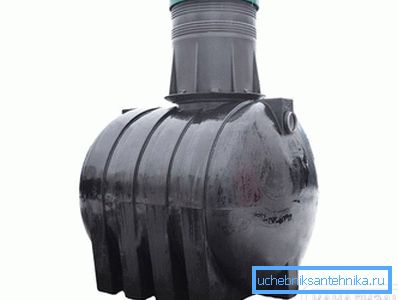
Most often, such a product is installed below ground level, having previously excavated a special pit, where the unit is placed. Thanks to this you can save the general appearance of the plot and a precious place that can be used for other purposes.
It is worth noting that before buying a tank you need to decide from which material to buy the product. After all, a lot depends on it. To help you with this, let's consider what these materials are and what is the advantage of each of them.
What do sewage tanks do
Depending on the material that is used, all sewage tanks can be divided into the following types:
- Plastic tanks.
- Metal tanks.
- Concrete tanks.
Each material has its advantages and disadvantages, which we now discuss.
Plastic products
The most common containers can be called plastic waste storage tanks. They have a large number of advantages, which we will talk about later, and thanks to them are so popular. In addition to the volume, they have no restrictions for collecting waste. All that is required of you is to perform the installation, after which the unit is ready to perform the assigned tasks. The good news is that the installation is very easy, it does not require special heavy artillery, it is enough to use strong male hands. What are the advantages of such models:
- Low weight, which facilitates the installation itself, allowing you to do everything yourself without any problems.
- The highest tightness, which is achieved during the manufacture, because the product has no welds. Therefore, you do not need to be afraid that not entirely pleasant content will leak out.
- Durability. As everyone knows, plastic is not subject to corrosion and is resistant to various adverse effects of aggressive substances contained in sewage. The life of such a product is 30 or even 50 years, which is quite good.
- Good strength. Despite the fact that it is plastic, it is not inferior to metal products and can withstand various mechanical effects and loads.
- Relatively low cost. If we talk about the other two types, they will cost you more, and transportation will also be expensive.
Metal products

Such containers occupy an honorable second place for using sewage waste for collection and storage. Although earlier such structures were used more often, since many industrial enterprises were falling apart, and it was very easy to get such barrels. The peculiarity of their installation is due to the fact that the tanks are very heavy, so for their installation you will need to hire a crane. If you want to do everything with your own hands - you will not succeed. Keep this in mind when calculating, as you will have to pay for renting heavy equipment. Moreover, some costs should be allocated to the sealing means, since immediately before installation all welds should be processed by them. Due to this, good sealing can be achieved, and wastewater should not fall into the ground.
The main advantage of metal tanks is that they are durable and reliable. They are hard to damage: they are well tolerated by mechanical stress and load. But there are still more minuses:
- The metal is corroded. That is why before installing the tank needs an additional anti-corrosion coating, both inside and outside. This can significantly extend the life of the product, however, does not completely solve the problem. Over time, it simply rot.
- A significant part of the tanks is made of thin sheets of metal, which under the influence of aggressive substances will serve you for a short time.
- The high cost of the product.
- Large weight, which complicates the installation process itself and makes it more expensive. Not only does the product itself cost more, it also has to pay extra for transportation services, crane hire, purchase of sealant and other installation services.
- Limited volume Barrels of 200–250 l are used as standard for storing and collecting waste. This leads to the fact that you often have to extract content, especially if you have a large family. Everything would be fine, the work can be done independently (although this is inconvenient and you need to use special equipment), but where to put the waste? Therefore, it is necessary to resort to the services of vacuum trucks, which is not entirely advisable for 200–250 liters.
Concrete Products
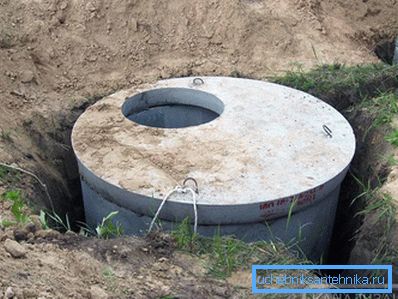
Very rarely for the collection and storage of waste used concrete tanks. If earlier it would be advisable, then today, when we have other materials that have excellent properties and are better suited for this purpose - concrete is significantly inferior. And it is mainly associated with the properties of the material itself. Concrete is simply helpless against moisture and water, which simply destroys it. That is why such a reservoir will not serve you for a long time. At the same time, you will spend a significant amount of money and effort on its equipment. Just as in the case of metal products, for the installation of concrete structures will require special equipment. Talking separately about some pros and cons is not worth it, since everything is clear with this. Today, concrete structures are practically not used.
What material for storing waste to choose - a purely personal matter. You can compare the pros and cons of a particular type and highlight the best. But frankly, plastic structures are the most profitable. All you need is to calculate the required volume, buy the unit and install it, that's all! Easy, simple and reliable! These tanks will serve you faithfully for many years, and they do not require constant care. Let's look at how to choose the right plastic tank so that it is comfortable and serves for a long time.
Rules for choosing plastic barrels
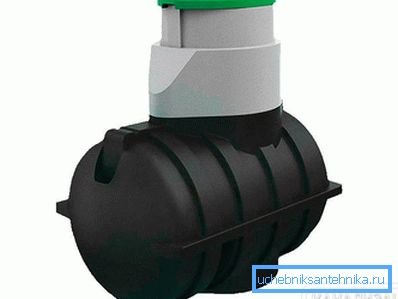
So, deciding to use a plastic tank for storing waste, the first thing you need to do is go to a specialty store and purchase such a unit. But how to choose the best option? What are the selection criteria? Let's find out.
- First of all you need to decide on the capacity (volume) of the tank, which is very important. Since it stores waste, keep in mind that from time to time, as the container is filled, you will need to deflate the contents. If you don’t use a shower and use water sparingly (often this happens at a dacha), then on average 10-20 liters of waste will be consumed per tenant. If, however, take into account the use of the shower (which is simply necessary for residential buildings), the rate is about 200 liters per occupant. On average, this number can range from 100 to 150 liters. Given all this, count the number of your household and determine the desired volume of the product. Below will be dismantled a special formula, thanks to which you can calculate the optimal volume.
- Particular attention when buying should be paid to the neck. The tank must be equipped with a high hatch. Why, you ask? It is required so that the tank can be covered in the ground with a concrete slab. Then it will be reliably fixed and safe from external factors and excessive pressure. Moreover, the plastic reservoir is quite light, therefore it can be squeezed out of the ground under the influence of groundwater. That is why the high neck and the installed concrete slab are important. And already on top of the slab poured a layer of soil. Moreover, choose products with a wide neck, because later it will be much more convenient to work with it when you use various fecal pumps.
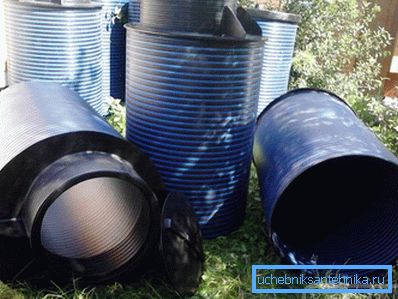
- It is worth paying attention to the manhole cover, which should be massive enough and have a screw thread to close tightly. This is very important, since any person can step on it, so if the cover is massive and reliable, it will not break. And so that you can easily unscrew the cover itself, it must have a handle or technological tabs. When the lid closes tightly and tightly, you will not smell the extraneous "odors" of sewage.
- Give preference to such models that have their own stiffeners, so that the whole structure becomes more reliable and gains the best durability. Why is it important? As you know, each flat object, the same sheet of metal, plastic or wood plank, is easier to break or bend across the plane than along. Since we are talking about a tank that has a fairly large volume, stiffening ribs, which should go along a possible bend, make the whole structure more rigid and give it greater resistance to external factors. This model will serve you much longer.
- The shape of the plastic tank, convenient maintenance and the ability to upgrade the design are some of the important nuances. Some structures have the opportunity to further develop the system and purify wastewater on the spot, releasing purified water or sludge. This, of course, is not the main thing that such a structure should have, but still, if it can be refined in the future, then it is pleasant.
Considering all the recommendations, you can buy a container that fully satisfies your needs and which would serve for a long time and reliably. Now that everything is ready, you can proceed to the installation work that you can perform on your own.
Preparatory work for the installation of the tank under the sewer
The whole essence of the work lies in the fact that you need to dig a large hole under the tank and bury it. It all comes down to land work, for which you need to stock up on such tools:
- shovel, depending on the number of assistants;
- shovel;
- buckets;
- scrap, for working with soil in which there are a lot of stones;
- a plumb to adjust the verticality of the pit;
- level;
- hammer;
- roulette;
- pegs and rope to make markup.
Having all the necessary tools, you can proceed to the preparatory stages. Often they are divided into 3 categories:
- Preparation tools.
- Calculate the desired volume of the tank.
- Choosing the best place.
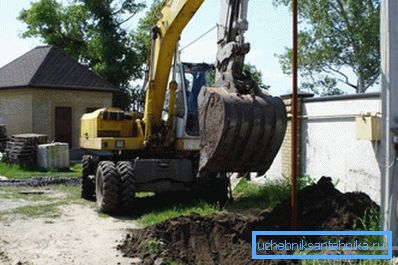
With the tools already figured out. As for the volume of the tank, as mentioned above, there is a special formula, thanks to which you can decide on how much volume is needed. This formula looks like this:
V = n? X? V day.,
Where:
- V is the required volume;
- n - the daily period after which you want to carry out cleaning work;
- x - the number of residents who live in the house;
- V day - the volume of wastewater, which is assumed to be 1 person per day.
For example, to understand, let's imagine a family that consists of 3 members. On 1 person per day takes about 150 liters of wastewater. You want your tank to be cleaned every two months, that is, every 60 days. Now it turns out:
V = 60? 3? 150
Using the calculator, you can immediately determine that your desired volume is 27,000 liters. It turns out that a tank of not less than 27 m is suitable for your needs.3, which you will have to clean every two months. You just have to substitute your numbers and draw certain conclusions.
Tip! Calculate the volume of the tank is quite simple. Although if you neglect this moment, it can lead to negative consequences.

Now you need to choose a suitable place on your site. Just poking a finger at any plot you like is the wrong tactic. There are special tank placement requirements that must be followed:
- To sewer drains freely and by gravity flowed into the tank, it must be installed at the lowest point of your site. Then the pipes will be inclined, and blockages will not form in them.
- In order for the tank to be conveniently cleaned, it is important to ensure access to the site so that the assenizatorskaya machine can easily get there. And this should be done despite the fact that you plan to clean the tank with your own hands.
- It is recommended that the sewer pipes through which the drains enter the tank are straight. Because of this, you do not have to install additional equipment, such as, for example, rotary wells.
- In order not to “enjoy” unpleasant smells from the container, you should not place it too close to the house. But even if the reservoir is located far away, this will lead to additional wastes, since the length of the pipeline will be longer. The most optimal is the distance from the tank to the house of 6 m.
All you have to do right before work is to choose a place and begin installation. This is what we will do now!
Installing a plastic tank
One of the important advantages of plastic products is ease of installation. Even if you do not have proper experience in construction and plumbing, you can do everything with your own hands. All you need is the right tools, following the instructions, some help from a friend or relative and, in fact, desire! Let's divide all the work into several stages so that you can more conveniently and clearly understand:
- First of all in the place chosen by you it is necessary to dig a ditch or a hole for the tank. For this, it is necessary to determine its dimensions, which directly depend on the unit itself. The pit should be equal to the size of the product, plus you need to make a small gap on each side of 50 cm in order to secure it further.
- So, having learned the necessary dimensions, for convenience, they can be applied to the ground itself, that is, to make the markup. In this case, you will need a tape measure, a hammer, a rope and pegs (you can take pieces of reinforcement). Mark the future place, you can begin to dig a pit.
- All work needs to be done with a shovel and a crowbar, if necessary. It will be easy for you to horizontally dig a hole yourself, but as you go deep, it will become harder and harder to work. Therefore, we recommend using the help of a "good" friend or relative who will help you. One of you will dig, fill the buckets with earth, and the other will pull them out and empty the ground. Periodically, you can change to save power.
- Do not forget to control all work by a plumb and level that there were no strong differences. It may be that the foundation pit will be uneven and the reservoir will simply not enter there. To protect yourself from unnecessary work on the installation and removal of the unit, initially control the digging process.When you do not want to dig the foundation pit yourself, and the accommodation and your funds make it possible to use special equipment, such as an excavator, the easiest way is to hire it to speed up the process and save energy.
- Digging a hole, you need to seal the bottom. Tamp it and make it more or less even. So that the barrel does not move during filling, you need to make a sandy pillow at the bottom, which will serve as the base. First put a 10 cm layer of sand at the bottom and tamp it down. Then top it with a 5 cm layer of gravel. Advice that if you live in an area where the soil is loose and clayey and the groundwater is close to the surface, it is advisable to make a strong base of concrete under the tank or install a 20 cm slab. Then the unit will stand securely in its place, without falling down and not bending down. You can mix concrete or order it. So that it does not crumble and be stronger, make a frame of reinforcement.

- Now it remains to put the container in the prepared place. If the product is large enough, this work requires the help of friends. In extreme cases, in the presence of huge tanks, resort to the help of special equipment. It should be borne in mind that you need to put a plastic container horizontally, and the inlet should be located closer to the sewer pipe. For reliability, the tank can be secured with cables to the base.

- As soon as everything is done, it is required to bring and connect the sewer pipeline to the branch pipe with a two-way coupling. To ensure the slope, at the point of passage of the pipe to the nozzle, it may be necessary to dig a trench.
- For reliability, all joints should be checked for tightness in advance, so that you do not have to get to the pipe inlet again. To check for leaks, a large amount of water must be fed into the system under pressure.
- Now the tank should be filled up. Moreover, more than half the volume should fall on the sand. Put sand evenly on all sides. In order to compensate for the difference in pressure, one should fill the tank with water as the sand falls to sleep. Then the structure is not deformed and will not be crushed. Then all the liquid can be pumped out.
- The rest of the space can be filled with soil, which remained during digging. On the surface should remain only the hatch, which must be tightly closed. And on that ground you can later plant a lawn to decorate the site. Advice that in the overall picture of your manor the presence of a plastic tank for sewage does not affect.
That's all the work is completed, and your tank is ready for operation. If everything is correctly selected and installed as it should be, then it will serve you for many years, making your stay in your home comfortable and enjoyable.

And in order for you to know when it is time to clean the tank, you can use a signal float. Some items include such an element, but if you don’t have one, it doesn’t matter. You can do it yourself. To bring the idea to life, take a steel bar, a bright foam ball, an aquarium suction cup and glue “liquid nails”. So, first apply the scale markup on the rod. Better - if it is fluorescent paint. At the end of the steel bar, place the suction cup that you want to glue to the bottom. So the rod is securely fixed and will not damage the bottom. Well, in the end it is necessary to attach a bright ball to the rod, which will move freely along your scale. Place the float so that, by opening the lid, you can immediately see where your ball is located. It will indicate the amount of content.
As you can see, it is not so hard to equip a container for sewage collection. All work can be easily performed independently without the help of professionals, who, by the way, would charge you a decent amount of money for this service. The use of such a plastic reservoir is expedient, the material has a large number of advantages, and such a construction will serve you for a long time. This can be said to be an intermediate solution between the cesspool and the septic tank, and it is justified from an environmental point of view.
If you liked the article, write to us about it! We will be more than happy to help you solve various problems and questions.
Video
The following video demonstrates the installation of a plastic sewer tank:
See also:
- How to make a cesspool of tires.
- Cleaning the cesspool.